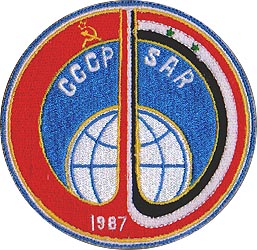
|
|

| Crew & Mission |
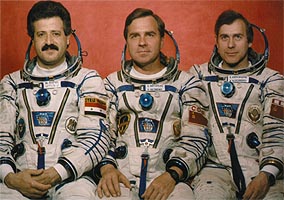
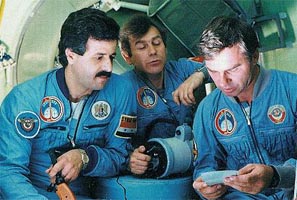
Soyuz TM-3, with the twelfth Interkosmos-crew - the first to fly to Mir, was launched from Baikonur on July 22, 1987. The capsule, with Aleksandr Viktorenko, Aleksandr Aleksandrov and Syrian Muhammed Faris aboard, docked to the Kvant module at the rear end of the Mir space station on July 24. They were welcomed by Mir-2 crew Yuri Romanenko and Aleksandr Laveikin, who had arrived at the station in February.
During his week-long stay, Faris carried out research into the Earth's natural resources (Yefrat), conducted technological (Palmira & Kasyun) and geophysical experiments (Bosra) and worked in the field of space medicine with experiments called Kontrast and Anketa.
Faris returned to Earth aboard Soyuz TM-2 on July 30, 1987, together with Soyuz-commander Viktorenko and Mir-2 Flight Engineer Aleksandr Laveikin, who had developed "an irregularity in his heart rhythm" and had to be replaced. During the Shuttle/Mir-program, it became known to NASA psychologists that the decission to break up the 174-day Laveikin/Romanenko partnership was prompted by "interpersonal issues" as well.
TM-3 crewmember Aleksandr Aleksandrov, who heard about his new assignment just a month before launch, remained aboard the station with Mir-2 commander Yuri Romanenko. The same day TM-2 landed, Romanenko and Aleksandrov undocked TM-3 from Mir and positioned it to Mir's front docking port, allowing Progress-31 to link up with the station a couple of days later.
Romanenko and Aleksandrov, not selected to fly together, had their own "interpersonal issues" as well, but with strong support from the ground, they managed to complete the mission. The two cosmonauts returned to Earth aboard the Soyuz TM-3 capsule on December 29, 1987, along with newly arrived TM-4 crewmember Anatoli Levchenko. Neither Romanenko (who retired within a year following his return from Mir), Laveikin or Aleksandrov ever returned to space.
The back up crew for the Soyuz TM-3 mission consisted of commander Anatoli Solovyev, flight engineer Viktor Savinich and Syrian cosmonaut Munir Habib.
| The Real Thing |
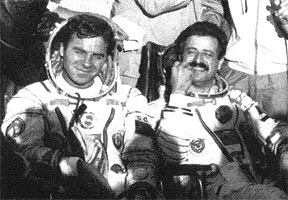
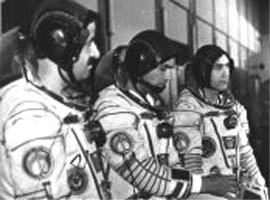
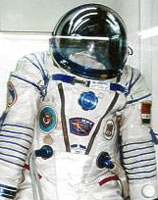
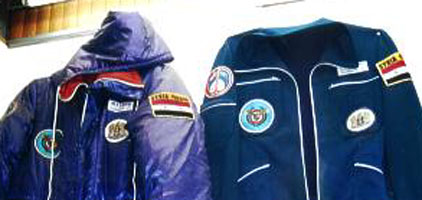
Left: The Sokol suit of Syria's back-up cosmonaut Menir Habib. This is the earliest example of a second generation Mir-patch attached to a Sokol-suit. It yet had to make its flight debut during Soyuz TM-4. Right: Habib's cold weather survival and PK-14 suits.
The mission patch was worn before and during the mission by all three Soyuz TM-3 crew members. During training, the patch was worn on either the left (Sokol) or right (training flightsuit) chest, making it more visible for pr-photography. During the mission, the patch was worn on the right sleeve by all three on both Sokol and PK-14-suits. Both suits of Faris were completed by a Syrian flag on the left sleeve, a Syrian seal on the left chest and a national Syrian aerospace-related patch on the right chest.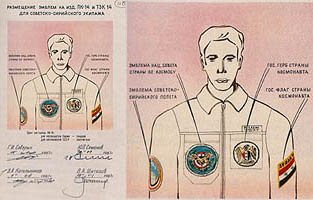
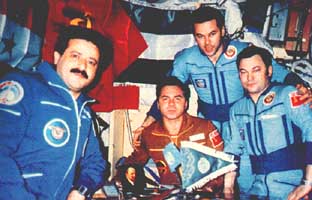
Left: The official document approving the layout of patches on Faris' PK-14 suit. Right: Faris, Viktorenko, Laveikin and Romanenko aboard Mir.
In addtion to the mission patch on the right sleeve of their PK-14 jackets and Sokol-suits, the Russians were wearing a CCCP-flag on their left sleeves (silk type, rounded lettering on PK-14; fully embroidered on Sokol), a Soviet seal on the left chest and a cyrilic Interkosmos-patch on the right chest. On the front of their Sokols, all three had an additional first generation Mir-patch.
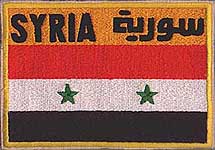
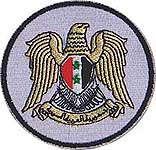
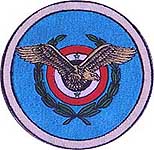
The three other patches worn by Faris: the Syrian flag, the Syrian seal and a Syrian aerospace related patch.
| Source |
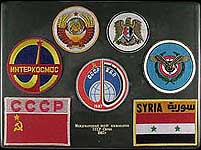
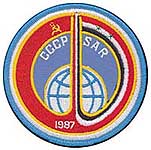
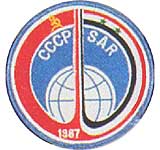
The original patch (along with a Syrian flag and a CCCP-flag, Syrian and Soviet seals, the Syrian national aerospace patch and an Interkosmos patch), has been available as part of a presentation set, offered to high Soviet spaceflight officials. We managed to get our hands on one such set at a Superior Auction.
Two souvenir versions exist: one made by Stewart Aviation in England and one by the Space Commerce Corporation in Texas. Stewart's version can be recognized by the lack of yellow "rings" in the design. The original picture was provided to Stewart by Luc van den Abeelen. ,,The yellow did not show up in it", he explains. The SCC-version is smaller (making the proportions a bit different) and has a thick overlock border.